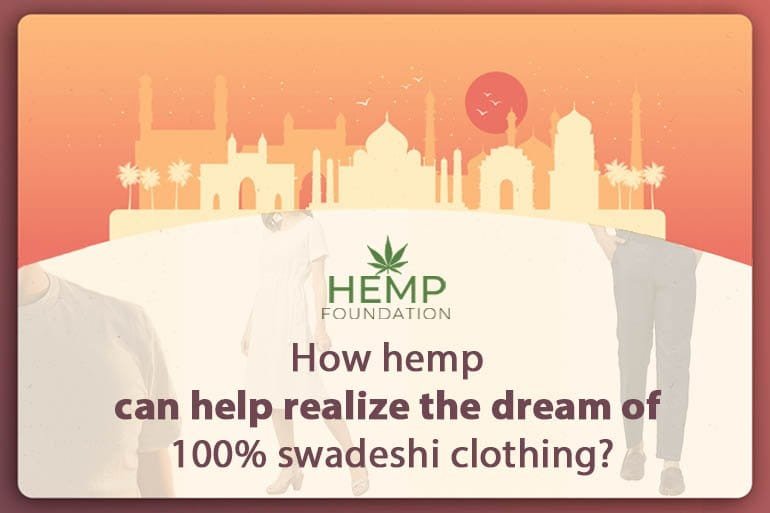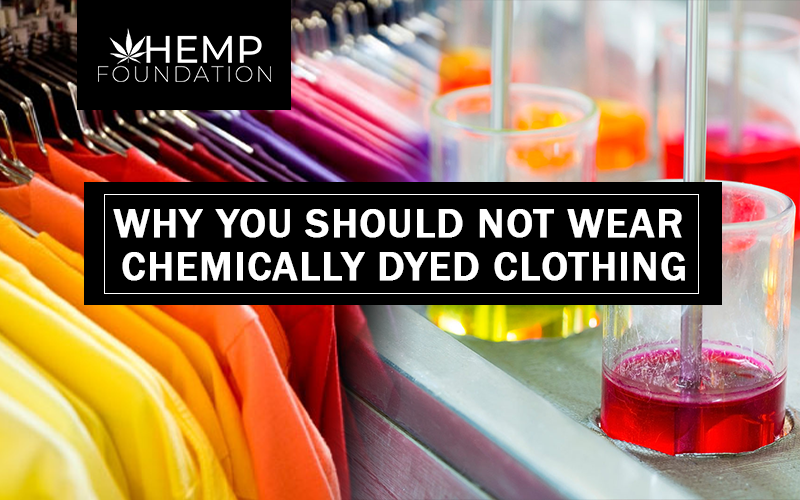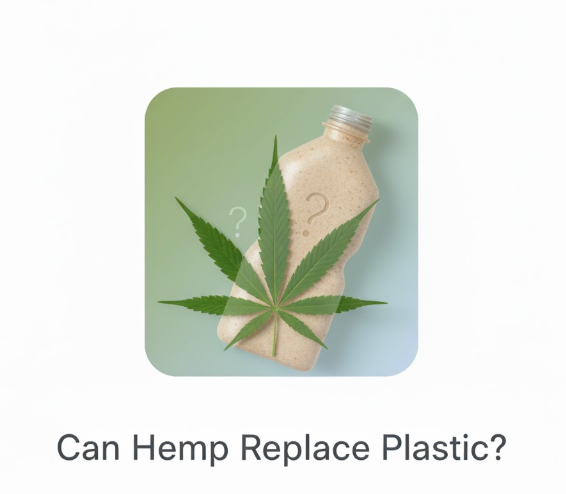How hemp can help realize the dream of 100% swadeshi clothing?
[vc_row][vc_column][vc_column_text]It is going to be a complete year when the current pandemic made its way to India and brought a massive change in almost all the key spheres of life and society – right from healthcare to governance and economy of India. We experienced a huge drop in bilateral trade. The textile sector was among the worst-hit sectors with a total trade impact of 64 million dollars (as per records of 2020 – first quarter).
Amidst this negative scenario, the Prime Minister invited the Indian consumers to support locally manufactured goods. ‘Vocal about Local’ isn’t just a slogan but an ideology that has to be turned into reality by assessing the current challenges besetting local production and finding the best ways to solve them.
Talking about the textile industry, the agricultural practices play a vital role in determining the costs, availability, and saleability of textile followed by other phases like production, transportation, etc. For India to produce 100% swadeshi clothing it has become very important to introduce a cost-effective fabric crop that is eco-friendly, farmer-friendly, and consumer-friendly. While cotton is highly popular in India, its extreme effects on the environment, high-cost farming, and heavy carbon footprint make it necessary to look for a substitute that shares all the pros of cotton without any of its cons. Hemp comes up as an almost ideal choice here.
[/vc_column_text][/vc_column][/vc_row][vc_row][vc_column][vc_column_text]
Increasing investment in eco-friendly fibers
[/vc_column_text][vc_column_text]One of the major hurdles for swadeshi clothing is the lack of investment to the tune of capital that is being spent by other countries. However, the present scenario has started changing rapidly. More and more investors are now investing in eco-friendly fabrics like Hemp fabric which requires half the water needed by cotton and produces around 200-250% more fiber.
Another major thing to be observed is that more often such investments are tied with empowering marginal communities or ground labor/key producers. Some critics call this a popularity stint to gain media attention while others appreciate it as a social business approach. Regardless of the intention/objectives, this approach will certainly help in strengthening the swadeshi clothing – right from infrastructure accessibility and capital to creating market presence.
More importantly, the increasing interest of investors will also unlock the saleability potential of hemp fabric- offering it a stronger personality and wider acceptance among the masses. While we don’t say that it will bring some overnight reforms, it will certainly play an important role in creating a positive ecosystem for starting swadeshi fabric manufacturing in India.[/vc_column_text][/vc_column][/vc_row][vc_row][vc_column][vc_column_text]
Promising future
[/vc_column_text][vc_column_text]Investors always prefer to invest in businesses that have good future potential and a positive demand-supply equation. Hemp fabric fulfills these requirements. It has been estimated that within the coming 5 years the hemp market will have a 27.2% of CAGR (Compound annual growth rate).
Secondly, unlike conventional fabrics like cotton, the hemp fabric market isn’t saturated. The steady upsurge of new hemp-focused enterprises also promises that it will register sustainable growth over several years. What’s even more exciting is that the recent developments in the field of hemp-based production have attracted the attention of research organizations, government bodies, and other key institutions that are actively assisting in leveraging the commercial value of hemp fabric.
Ironically speaking, the current vague standards on the legality of industrial hemp farming also have a certain role to play in attracting more investors. While diversifying their portfolio the many smart investors look for something that affords them a competitive edge over others. Compare it with investing in penny stocks that are deeply studied by seasoned stock investors who are almost certain about their future potential.
The vague standards on hemp farming and businesses mean the field will not register a high competition at least for a few years from now. Low market penetration and competition allows investors to enter with a lower investment. At the same time, the present attempts ensure to accelerate its future saleability potential and deeper market penetration which means they (investors) can reap higher returns in the future. It will offer them the first-mover benefit.[/vc_column_text][/vc_column][/vc_row][vc_row][vc_column][vc_column_text]
Hemp fabric can attract high-spending buyers
[/vc_column_text][vc_row_inner][vc_column_inner width=”1/6″][/vc_column_inner][vc_column_inner width=”2/3″][tm_image align=”center” image=”13520″][/vc_column_inner][vc_column_inner width=”1/6″][/vc_column_inner][/vc_row_inner][vc_row_inner][vc_column_inner][vc_column_text]One of the major reasons why people with high spending capabilities love to buy imported fabrics with unreasonably high price tags is due to quality and durability. It certainly hurts Made in India fabrics. Hemp fabric offers an ideal solution to this issue. Hemp fabric is naturally stronger than its conventional counterparts like cotton fabric.
When compared to the tensile strength the hemp is 300% better than cotton. This extreme tensile strength enhances the durability of hemp fabric. Another major concern of buyers is how a fabric fares in retaining the original colors. Here also hemp emerges as a clear winner as its colors are more vibrant and it enjoys excellent fading resistance capabilities. Versatility is another plus point of hemp fabric.
You can either buy an original, natural hemp fabric or opt for your preferred blended fabric- thanks to its seamless blending qualities with various synthetic and natural fibers. Thanks to its strong natural repellent qualities hemp fabric can be stored for a long time without any risk of insect/mold-induced damages.
Another vital factor that affords it a superior position than cotton is that unlike the latter, the hemp fabric does not weaken with each wash. Instead, it gets stronger every time you wash it.[/vc_column_text][/vc_column_inner][/vc_row_inner][/vc_column][/vc_row][vc_row][vc_column][vc_column_text]
Hemp fabric can attract institutional buying
[/vc_column_text][vc_column_text]One of the major concerns of any swadeshi fabric is institutional buying at least during the initial phase. We certainly cannot expect that every entrepreneur will stuff their shops with your swadeshi cloth as soon as you will introduce it. Just like any new product the swadeshi fabric also takes some time to get market acceptance. Institutional buying in such circumstances acts as a reliable cushion to support the market presence even while going through the low-demand phase.
Due to its high strength, versatility, and superior qualities, hemp fabric can be a good choice for specific professionals. We have already written a detailed article on how hemp can prove to be a purpose-friendly fabric for the military. The similar qualities also make it a good option for athletic wear brands which will also protect the Indian athletic associations from investing heavily in imported sportswear.[/vc_column_text][/vc_column][/vc_row][vc_row][vc_column][vc_column_text]
Eco-friendly fabrics will gain momentum in coming years
[/vc_column_text][vc_column_text]Looking at the current scenario, the upcoming years will mark a sharp rise in the commercialization of eco-friendly products. The rising concerns on climate change and a global level commitment to preserving the natural resources have graduated from cosmetic ideas to pragmatic provisions. It means that in the next decade the eco-friendly alternatives like hemp fabric will gain better acceptance not only in India but in other countries as well.
One of the major reasons for being so optimistic on hemp fabric’s future potential is the way it compares to the current leader in the market- cotton. The latter does offer natural breathable fabrics to mankind but it leaves a very huge carbon footprint. In short, it depletes huge natural resources for while hemp has very modest demands in terms of volume as well as variety. Unlike cotton, it doesn’t need pesticides or herbicides (major contributors to agriculture-related carbon footprint) as hemp is naturally resistant to pests.
Secondly, hemp requires just half the amount of water needed for cotton farming thus saving a huge amount of this quintessential natural resource. Thirdly unlike cotton, hemp does not harm the fertility health of soil but contrastingly, hemp farming improves the soil quality over some time duration.[/vc_column_text][/vc_column][/vc_row][vc_row][vc_column][vc_column_text]
Closing thoughts
[/vc_column_text][vc_column_text]What makes it all the more beneficial is the positive commercial returns of hemp farming when compared to cotton farming? Not only hemp farming can be practiced in the same area of land constantly (which is not possible with cotton farming due to deteriorated soil health) but hemp also produces a higher volume of fiber per hectare when compared to cotton which makes it an excellent crop for farmers regardless of their economic stature.
In short, any crop that requires lower growth capital and offers higher yields allows the farmers to enjoy some good cost benefits that allow them to sell the product at a lower cost. The cost gains at the farm level are continued to the factory level and eventually encourage shops to sell good quality hemp fabrics t the end consumers at pocket-friendly prices. Blending environmental benefits with commercial viability will certainly reduce the time and efforts needed to introduce hemp fabric in the mainstream fabric market of India.[/vc_column_text][/vc_column][/vc_row]




